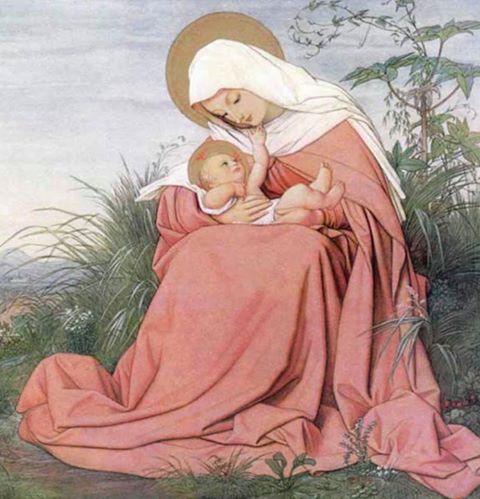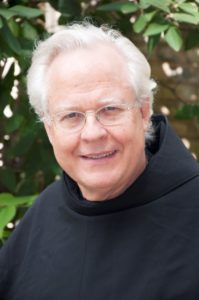 The “Fullness of Grace” in Christ and the “Fullness of Grace” in Mary
The “Fullness of Grace” in Christ and the “Fullness of Grace” in Mary
Num 6:22-27; Gal 4:4-7; Lk 2:16-21.
Hail Mary “full of grace” the Lord is with Thee, blessed art Thou among Women and blessed is the Fruit of Thy womb, Jesus. Holy Mary Mother of God pray for us sinners now ….
Does Mary’s fullness of grace co-exist alongside that of Christ’s fullness of grace? Bl. John Duns Scotus answers: equal “fullness of grace” alongside of Christ is impossible. God has absolute power and can grant as much grace as was granted to Christ to any nature, to Mary. God cannot do this by his ordinary power[1] because there cannot be more than one Head in the Church, from whom every grace would flow into her members.[2] The Head of the Church is Christ and we are His Body.
Christ and Mary have the “fullness of grace” on different levels. Christ’s fullness is absolute. Mary’s fullness is relative. His is natural. Hers is participated. The origin of the fullness of grace in Christ is immediately from God. The fullness of grace in Mary is immediately from Christ. To Duns Scotus, Christ presents himself to us as the absolute, natural Mediator; Mary is a relative, moral Mediatrix. We can never say enough about Mary, nor, even minimally, compromise Christ’s natural fullness of grace. By exalting the dignity of the Mother of God, all the more we exalt the dignity of the Son.
Duns Scotus overcomes difficulties in answering the total transmission of Christ’s grace into Mary.[3] God’s absolute power and ordinary power is a tool in our tool box. Advent and Christmas bathe us in Art, Icons, Sacred Music, Literature AND Religion which provide lift for understanding the mystery of God’s counsels and lift to our hearts. An unending narrative of love and devotion to the Incarnation and to the Virgin Mary imbues the Eastern and Western Churches.
Listen to a revered Russian Orthodox theologian, Sergei Bulgakov (d. 1944): “It goes without saying, that even if we (the Russian Orthodox Church) do not accept the Catholic dogma of the “immaculate” conception, we must confess that the Mother of God is entirely full of grace.”[4] Faithful Catholics seek spiritual union with the Virgin Mary, a loving relationship with her who is “full of grace.”
Little known is that Maximilian Kolbe was excavating theological insight from the Russian Orthodox. Kolbe learned from Russian usage of “transubstantiation” as the union or communion of created persons with Mary Immaculate and through her with the Holy Spirit. No other theologian in the West has done this. In the West, “transubstantiation” touches on the Eucharist and Real Presence, to define how the essence of bread and wine is changed entirely into the Body and Blood of Christ.
In Eastern Rite theology, mainly in Russian theology, “transubstantiation” refers to the relations of persons to each other and to the Holy Spirit. Timing is right as the secular invasion is mounting. The novelist Dostoyevsky (d.1881) creates figures who mirror the deformation of modernity which he thought was caused by reason, the pathology or sin. Dostoyevsky became a counter to the Revolution of 1917 prior to the fact. Dostoyevsky (d.1881) stunned the literary world with portraits of radical alienation and deep questioning of Russia. Where is it? Where is it going? Is Christianity the solution or the problem?
Dostoyevsky’s questions apply equally to the Catholic world. His novels deal with massive human failure, massive human sin. If one considers Augustine on sin “very dark,” consider Dostoyevsky doubles how dark because of becoming demonic. Dostoyevsky draws out the contrast of light or becoming saintly.
During WW I, Kolbe was a student in Rome, a reader of Russian thinkers, co-founder of the Militia of Mary Immaculate. As a priest he innovated use of the media, taught the theology of the Franciscan School, corrected his confreres if they bore even a hint of anti-Judaism, and became “martyr of charity” in Auschwitz. Kolbe founded a City of the Immaculate in Poland, then in Japan. Who knew the hope he would be graced to bring to prisoners in man-made death camps? After 1941, his Marian metaphysics would be left for others to explain and to develop[5] as Peter D. Fehlner.
At the end of the 19th and beginning of the 20th centuries, Russian Orthodox theology was engaging the cultural changes and flowering. What could be heard after the Revolution of 1917, in Chesterton’s phrase, was an audible hiss of Satan. In 1923, Bulgakov fled Russia by the skin of his teeth and established a theology center in Paris where he died in 1944. Catholic theology, effectively put on hold by external and internal historical reasons after Vatican I, burst forth as the event of events under the leadership of Pope John XXIII and Paul VI at Vatican II to reform and renew the whole Church. Kolbe was beatified in 1971 and canonized in 1982. The cause of the Immaculate remains at the heart of the Franciscan counterthrust to the secular invasion.
The Solemnity of Holy Mary Mother of God draws us to reflect on complex doctrines that have developed about Mary’s spiritual Maternity and divine Maternity. Centuries of practices and devotion to the Mother of God included the love, devotion, and hymns from my Slovak ancestors (parish, school, neighborhood). At 14, with no little trepidation, I began to walk in the footsteps of Christ as a Franciscan. Little did I know Mary’s spiritual Maternity and divine Maternity as experienced by Francis of Assisi and how this became a bulwark reaching the secular invasion today. I realized more what Fr. Fehlner would say: Our Lady chose the Franciscan Order to unravel the theological development that led to the solemn definition of the Immaculate Conception in 1854.
As Dostoyevsky did with novels, Gerard Manley Hopkins, S.J., did with poetry. He discovered the thought of Bl. John Duns Scotus, theology that expresses what God can do (potuit), what is fitting (decuit), and what God does (fecit). The literature of Dostoyevsky and Hopkins connect with a nostalgia for the loss of Christianity, its mourning, even as they do not substitute their work for religion.[6] Hopkins offers a “hurrah moment” with Scotistic inflections in his poetry: “She mothers each new grace that does now reach our race—Mary Immaculate, merely a woman, yet whose presence, power is great as no goddess’s ….”[7]
Remember this New Year: Christianity is a mix of treasure and human frailty, saints and sinners. Let us dare to hope! With Duns Scotus let us “attribute to Mary what seems most excellent, provided that it does not oppose the authority of the Church, nor that of Scripture.” This principle is favorable to resolution of any questions about her as the “fullness of grace” from the East and the West.
[1 Jan Mother of God, Golden Jubilee / Priesthood Fr. Edward J. Ondrako, O.F.M.Conv. eondrako@alumni.nd.edu]
__________________
[1] See E. Ondrako, Rebuild My Church (Hobe Sound, FL: Lectio Publishing LLC, 2021), 33.
[2] Duns Scotus, Ordinatio, III, d. 13, q. 4, n.8 (Vivès 14, 461b).
[3] R. Rosini, Mariology of Bl. John Duns Scotus, trans. P.D. Fehlner (New Bedford, MA: 2008), 61-62.
[4] S. Bulgakov, The Bride of the Lamb, trans. B Jakim (Grand Rapids, MI: W. B. Eerdmans Publ. Co, 2002), 411, n. 23.
[5] P. D. Fehlner, O.F.M.Conv. critically evaluates the theology of Kolbe. His definitive study is Theologian of Auschwitz (Hobe Sound, FL: Lectio Publishing, LLC, 2020). Studies of Kolbe’s thought continue to grow, especially from Conventual Franciscan Friars. A caveat: not all who claim a Kolbean adherence are as learned as Kolbe.
[6] C. O’Regan’s triple diagnostic of religion and literature is: retrievalist – loss and longing; antithetical – constructing religion as “once upon a time” ~ finding a substitution; parasitic – critical of Christianity but not totally dismissive.
[7] Gerard Manley Hopkins, “The Blessed Virgin Compared to the Air We Breathe.”
Fr. Edward J. Ondrako, OFM Conventual
Research Fellow Pontifical Faculty of St. Bonaventure, Rome
Visiting Scholar, McGrath Institute for Church Life
University of Notre Dame
December 26, 2021
